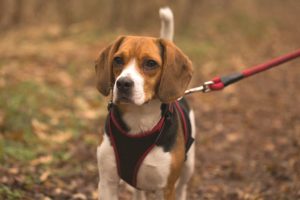How to Pick the Best Dog Harness
How to Pick the Best Dog Harness
You’d think the most challenging part of having a dog would be actually deciding to get one and then picking one out, right? Well, as many long-time dog owners will attest, that isn’t quite the case. Your dog will need specialized equipment to support their specific needs and behaviours throughout their life, and your dog’s harness is no exception.
Types of Dog Harness
Essentially, dog harnesses boil down to two types: back-clip harnesses and front-clip harnesses, which are sometimes called no-pull harnesses. This is where you’ll want to start narrowing down your harness choices based on your dog’s leash behaviours.
Back-Clip Dog Harness
Back-clip harnesses are perfect for small dogs as they’re generally easy to put on and allow for fewer leash/leg entanglement situations. Small dogs in particular need to wear a harness to lessen the pressure on their trachea from a leash and collar combo alone. Back-clip dog harnesses are generally more comfortable for them as well. However, if you’ve got a bigger dog or a dog of any size that pulls substantially, a back-clip harness will only exacerbate that issue.
Front-Clip Dog Harness
Pulling, specifically, is where front-clip harnesses come in. These harnesses tend to give the walker more control because the clip is at the dog’s front. When the dog starts to pull, the harness works to redirect them back to you to help curb the pulling habit. However, once your dog is walking calmly, the front clip front can allow the leash to get tangled in the dog’s legs which could be an annoyance for both you and your pup.
There is a third harness type that brings both the front-clip and back-clip together, and that is the dual-clip harness. These harnesses work best on big, strong dogs who tend to pull on their leash. The clip at the front acts as a brake, and the clip at the back acts as steering. These harnesses offer superior control but can be a bit more expensive than their one-clip counterparts.

Styles of Dog Harness
Vest Harness
These are generally the most common harnesses and might be what comes to mind when you think of a “dog harness.” They are often padded with very finished, soft edges, so there’s no chafing the dog’s undercarriage. These harnesses are better suited for small dogs, but they can be used for almost any sized dog as they come in both front and back clip variants.
Step-in Harness
A step-in harness is perfect for dogs that are a little larger or don’t like having things pulled on over their heads (like the vest harness). As the name implies, the step-in harness is one your dog can step into, leaving you to buckle it up on their back. These harnesses are generally nylon straps, so you’ll need to make sure the width of the straps is appropriate for your dog’s weight, so there is no discomfort while it’s being worn. Step-in harnesses are often a back-clip style, so you’ll need to be sure this clip style will work with your dog’s habits.
Roman
If you’ve got a harness escape artist for a pooch, this harness will be your best bet. The Roman harness goes over the head, then under your pooch’s front legs, and finishes with a band around the pup’s midsection. The double harness effect makes it much harder for dogs to slip out of these harnesses so you can be sure your pup will be safe on your walks.
Taking stock of your dog’s leash behaviours and shopping for a harness with those exact needs in mind will ensure you end up with the best harness for your furry buddy. If you can’t take your dog with you to try them on, make sure to get a harness with multi-point adjustments for an optimal fit. Once you’ve got the right harness, you’ll be ready to step out in safety and confidence that your dog is set up for success with the right equipment.
Thanks for reading. It’s getting hot out there so take a look at our guide to keeping your pets safe this summer!


Leave a comment